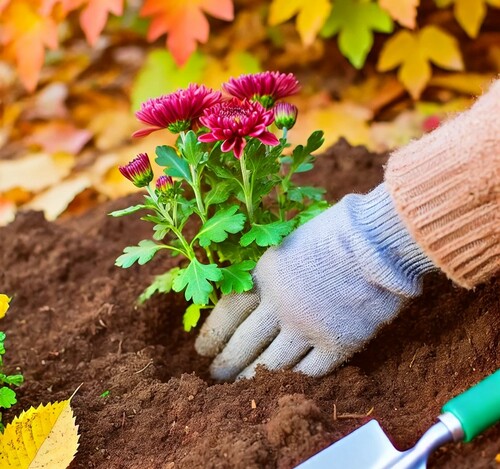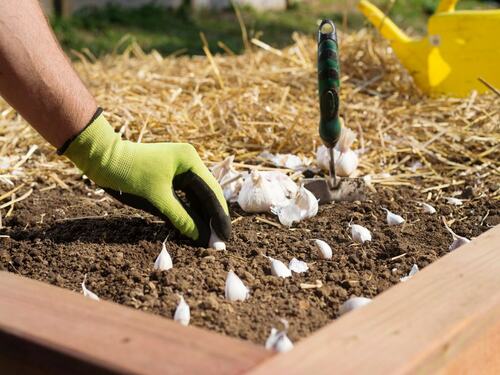Autumn is a Fine Time for Gardening
Introduction
In milder winter climates, autumn is one of the best times to plant a variety of garden plants and trees. Compared to spring-planted trees and shrubs, those planted in the fall often exhibit significantly more growth after the first year. This makes autumn the ideal season for establishing native or drought-tolerant plants as well as cool-season vegetables. By planting in the fall , perennials can get a jump start on growth, and cool-weather annuals and vegetables yield more bountiful harvests and enjoy longer production periods.
The Advantages of Fall Planting

Chrysanthemums Being Planted in a Colorful Autumn Garden
Reduced Moisture Loss and Enhanced Root Growth
Autumn’s cooler days and shorter daylight hours reduce moisture loss through plant leaves, allowing newly planted vegetation to establish itself more effectively. The warmth retained in the soil from summer encourages robust root growth, which is crucial for the development of future leaves. As winter rains soak the roots, an extensive root system begins to form. When spring arrives, warmer days spur rapid growth, with new leaves emerging and roots continuing to expand. This larger root system supports the plant through the hot, dry spells of summer, providing better access to water and nutrients. By the following autumn, plants are often considerably larger and healthier than those planted in spring, thanks to their well-developed root systems.
Lower Susceptibility to Root Rot
Plants started in the fall are less vulnerable to certain root rots that can afflict spring-planted vegetation. Spring plants, with their less extensive root systems, require more frequent irrigation. The combination of frequent watering and warm summer temperatures can create ideal conditions for diseases, particularly in California natives, which are especially prone to root rot fungi. Planting these natives in the fall reduces the risk of disease and promotes healthier growth.
Growing Cool-Season Crops

Garlic Cloves Being Planted in a Raised Bed for Fall Gardening
Early Start and Extended Harvest
Cool-season vegetables thrive when planted in the fall, benefiting from the lingering warmth of autumn to jump-start their growth. Even if these plants don’t produce immediately, they will be well-positioned to yield food or flowers in early spring.
Vegetables like cabbages, broccoli, cauliflower, lettuces, spinach, onions, carrots, radishes, peas, and other root crops are all cool-season crops that produce best in the cooler parts of the year. Harvesting typically ends as the weather warms in early summer, so planting these crops in the fall can lead to a longer, more productive harvest period.
Take Time to Plan
Availability and Selection
Fall planting can be limited by the availability of certain plants. To make the most of this season, gardeners should plan ahead by noting which plants are favorites when they bloom earlier in the year. This way, even if those plants are not in bloom in the fall, you can ensure they are included in your garden design.
While some plants may be harder to find, many perennials that were started in late spring or summer are readily available in fall. This season is also ideal for selecting trees and shrubs, as you can see the vibrant autumn coloration of specific plants, helping you make more informed choices.
Additional Considerations for Fall Planting

Amending Soil for Fall Gardening with Rich Compost
Soil Preparation and Planting Tips
Certain perennials, especially those prone to rot during the winter, require special attention during fall planting. Gardeners should amend soil with organic matter to improve drainage and plant health. Additionally, when planting, ensure the crowns of perennials are placed at or above soil level to prevent rot.
While fall is an excellent planting season, don’t overlook the importance of spring planting, particularly for frost-sensitive plants. At higher elevations , spring planting is often recommended to avoid the risk of frost damage. Generally, plants should be in the ground at least six weeks before the ground freezes, which may make fall planting unsuitable in high-altitude gardens.
Fall is the Best Time to Plant!
With crisp mornings, warm afternoons, and clear blue skies, fall offers the perfect weather for gardening. The season is also a delight for plant shopping, with nurseries brimming with colorful mums, pansies, trees, and shrubs displaying their vibrant autumn hues. Take advantage of this time of year to enhance your garden’s beauty and productivity.
Partner with Arborist Now for Year-Round Garden Care
At Arborist Now, we’re committed to being your gardening partner through every season. We can help you determine which trees and plants are best for fall planting on your property. You can rely on our expertise and dedicated customer service to meet all of your seasonal tree care needs. Contact us today to learn how we can help you create and maintain a thriving garden throughout the year.
Originally posted on October 13, 2020.


